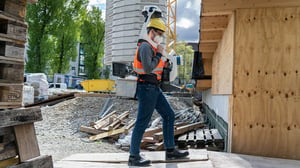A significant step for any construction project is the final handover process. Without the correct assessments, documentation, and transparency, it can be a challenge for building managers to operate sites effectively throughout the building lifecycle.
Documentation is of primary importance. However, issues with paperwork can often lead to complications and confusion, with inconsistent documents and inaccurate records.
At handover, all documents relating to the building are required by the owners to ensure successful operations and maintenance over the long term. Documents typically include as-built plans, the relevant certificates, permits, and warranties, as well as any manuals or structural reports. Close work permits are also often required after the final inspection, in addition to the identification of any necessary works required by the owners before they can move in. Alongside this, reports will be needed for fire safety and information regarding utilities.
Furthermore, many of these documents must be updated over the building’s lifetime, with continuous monitoring a crucial way to ensure that documentation remains up to date.
The necessary documents must be approved by all parties to ensure legal requirements and compliance needs are met when transferring ownership of the property.
The role of digitalization in construction projects
Even in this digital age, the handover process can be fraught with difficulties. Information may be difficult to access, resulting in a lack of transparency among the many stakeholders.
This is especially true with paper-based systems, where there may be limited copies of documents that can be difficult for various stakeholders to view as they may only be accessible at a singular location. These documents may be scanned and uploaded to a shared folder – but there is no guarantee that they can be easily accessed or understood by stakeholders and contractors with different levels of technical knowledge.

However, mobile mapping technologies are changing what is possible and not only helping to simplify the handover process but also making the information clearer and more accessible for stakeholders and contractors throughout a construction project and further.
The advantages of 3D documentation in project handover
The latest building documentation is critical to the project handover process. Yet such information has historically been in 2D and can be riddled with inaccurate measurements caused by human error. At the handover stage, all relevant parties must have a complete overview of the project so that contractors and clients can sign everything off with confidence.
To gain more accurate site models, 3D scanning is an optimum solution. 3D scans enable the fast resolution of such issues, as technicians, employees, and service providers can use them to navigate the building more quickly remotely.
Terrestrial laser scanning (TLS) processes can be costly and time-consuming, with TLS devices static. If any objects are in the way of the scanner, any data gathered will be incomplete.
Technologies such as laser scanning and mobile mapping can provide thorough building documentation more quickly and cost-effectively than TLS, with far greater levels of flexibility. Combined with simultaneous localization and mapping (SLAM), these technologies can capture on-site data up to ten times faster than other solutions, allowing information to be accessed by stakeholders efficiently.
An effective digital representation can enable a complete visualization that makes it easier for all stakeholders to understand the project and highlight any legal or compliance needs that must be met before the handover concludes. Such technologies can also be used by customers to request services and report faults when operations begin in the building.
Mobile mapping technologies for seamless project handover
A solution provider gaining traction in the construction industry is NavVis. The company provides a suite of mobile scanning solutions with many uses in the construction industry.
NavVis VLX 3 is a scanning device equipped with two sensors, one horizontal and one vertical, which emit approximately 1.28 million points of light per second to measure spatial distances with precision. Alongside this, digital cameras capture 360° panoramic images for a complete visual representation of the data. Spatial data and images are then uploaded via the cloud and can be accessed almost instantly on the NavVis IVION platform, with users able to move around the building layout virtually from wherever they are accessing it.

NavVis technology can be deployed from the very early stages of a construction project, which can be updated over time with continuous scanning through to completion and handover.
Crucially, at the handover stage, NavVis VLX 3 provides all parties with comprehensive and accurate data and images of a construction project. Through NavVis IVION, everyone has access to the same information to ensure clarity and consistency.
Digital scanning tech used in construction projects
One company using NavVis’ solutions in its operations is one of Europe’s largest construction service companies. The German company has been using NavVis tech to generate 3D models of sites that have been completed and others that are under construction.
The company began using NavVis tech due to a workforce shortage, notably in qualified surveyors. As NavVis VLX can generate survey-grade quality point cloud data and images, this provides a vital solution – especially as training for the device is relatively quick. The company typically uses the tech once or twice a week.
“It’s very easy to operate,” said a spokesman for the construction company. “You have about three buttons you need to push to use the VLX and [just] to walk through the construction site. So, everyone can use it. Processing of the data is as simple as the capture.”
“The online platform is enormously important, as it allows foremen, for example, [to understand] the size and condition of storage areas, as well as traffic safety measures,” he added.
With NavVis IVION acting as a hub of information and compatibility with other platforms and industry software, all stakeholders have access to accurate visualizations and documentation. This ensures consistency and clarity throughout a construction project to the handover and beyond.
Read more about the importance of reality capture in retrofitting and renovation projects, especially when it comes to reducing the environmental impact of construction →

